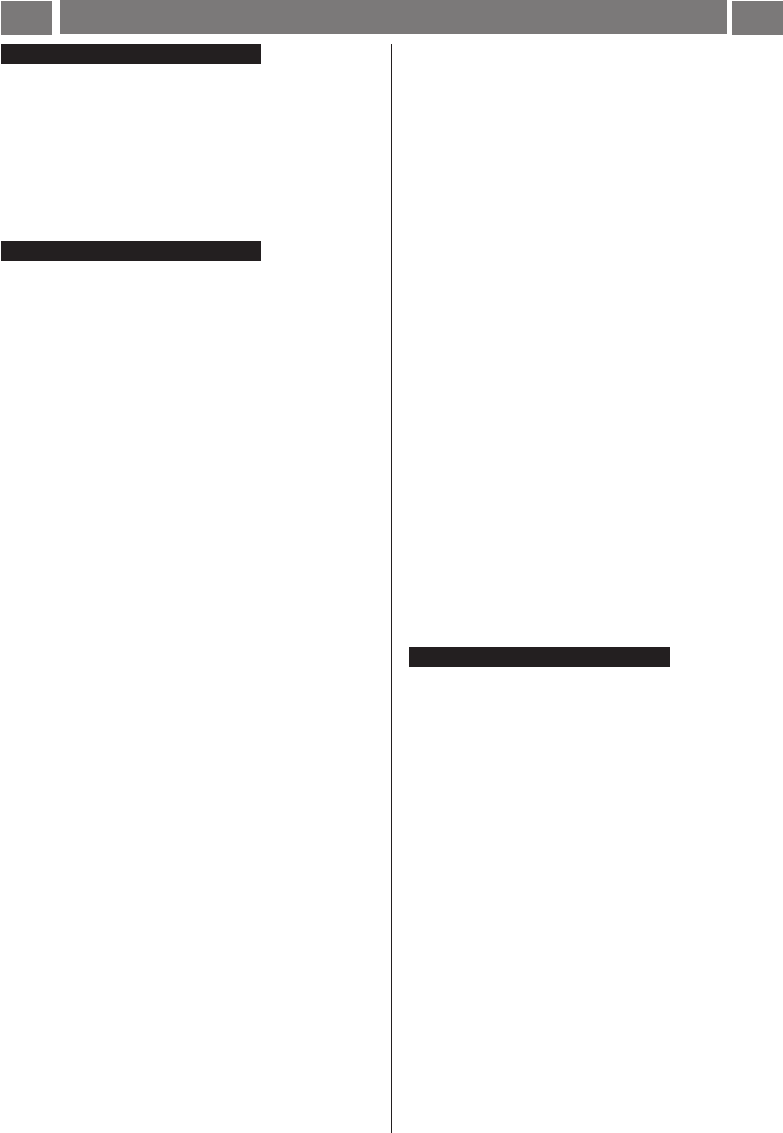
12
Cleaning
The cooker hood should be cleaned regularly internally and
externally.
For cleaning use a cloth moistened with denatured alcohol
or neutral liquid detergents. Avoid abrasive detergents.
Warning:
Failure to carry out the basic standards of the cleaning of the
cooker hood and replacement of the filters may cause fire
risks.
Therefore we recommend oserving these instructions.
Maintenance
Prior to any maintenance operation ensure that the cooker
hood is disconnected from the power supply.
Grease filter
This must be cleaned once a month (and, in the case of the
model with electronic control panel, each time that the letter
F alternated to the selected speed appears on the display
see previous page) using non aggressive detergents,
either by hand or in the dish-washer, which must be set to
a low temperature and a short cycle.
When washed in a dish-washer, the grease filter may
discolour slightly, but this does not affect its filtering capacity.
To remove the grease filter, pull the spring release handle
(f) - (Fig. 2).
Only for model with electronic control panel:
After washing the anti-grease filter, depress knob B (see
preceding page) for about 3 seconds. The letter F will
disappear from the display.
Charcoal filter (filter version only)
It absorbs unpleasant odours caused by cooking.
The carbon filter should be replaced every six months (and
in cases of the model with the electronic control panel, each
time that the letter C appears on the display alternated
to the selected speed see previous page).
1. Slide out the vapour collector.
2. Remove the grease filter.
3. If the carbon filter is already mounted and requires
replacement, depress the unblocking key (S - Fig. 10)
and remove the filter downward.
4. Remount the grease filter.
If the carbon filter is not mounted:
1. Slide out the vapour collector.
2. Remove the grease filter.
3. Insert the carbon filter in the upper hooks T and fix it using
the lower hooks S (Fig. 10).
4. Remount the grease filter.
Only for model with electronic control panel:
After replacing the charcoal filter, depress knob B (see
preceding page) for about 3 seconds.
The letter C will disappear from the display.
Replacing lamps - Fig. 4
Access the light compartment according to the model
in your possession, proceed as follows:
Warning!
Prior to touching the light bulbs ensure they are cooled down.
Model with halogen light bulbs.
Use a small screwdriver to act as a lever on the border
of the light bulb housing in order to remove the light bulb.
Replace the light bulb with a new PHILIPS STANDARD
LINE code 425409 12V 20W 30° Ø35 12V GU4.
Carry out the replacement and the mounting of the new
light bulb following the procedure in reverse.
Model with incandescent light bulbs:
Remove the vapour screen.
Remove the grease filter, it will then be possible to
access the bulb housing area.
Unscrew the damaged light bulb and replace it with a
new 40W max (E14 - B35) light bulb.
Model with PL light bulb.
Remove the vapour screen.
Remove the grease filter, it will then be possible to
access the bulb housing area.
Extract the damaged light bulb and replace it with a new
9W-G23 (Cooker hood with two light bulbs) or 11W-G23
(Cooker hood with one light bulb).
If the lights do not work, make sure that the lamps are
fitted properly into their housings before you call for
technical assistance.
Caution
This appliance is designed to be operated by adults. Children
should not be allowed to tamper with the controls or play with
the appliance.
Do not use the cooker hood where the grill is not correctly
fixed! The suctioned air must not be conveyed in the same
channel used for fumes discharged by appliances powered
by other than electricity. The environment must always be
adequately aerated when the cooker hood and other
appliances powered by other than electricity are used at the
same time. Flambé cooking with a cooker hood is
prohibited. The use of a free flame is damaging to the filters
and may cause fire accidents, therefore free flame cooking
must be avoided. Frying of foods must be kept under close
control in order to avoid overheated oil catching fire. Carry
out fumes discharging in accordance with the regulations in
force by local laws for safety and technical restrictions.
INSTRUCTION ON MOUNTING AND USE
GB


















